Consumer Insight Report: Marketing Strategies and Consumer Behavior
VerifiedAdded on 2020/06/03
|9
|2478
|117
Report
AI Summary
This consumer insight report explores the multifaceted realm of consumer behavior, focusing on the 'Game of Clones' and its implications. It delves into the dark side of consumer behavior, including deceptive advertising and telemarketing fraud, while also examining government regulations. The report provides a comprehensive literature review, discussing various consumer behavior theories, including the theory of planned behavior. It further analyzes different marketing strategies, such as the 3C model, STP model, and franchising, highlighting their advantages and disadvantages. The report recommends the STP model as the best marketing strategy for enhancing products and services, and concludes with suggestions to mitigate the negative impacts of consumer behavior, such as pirating practices, on business performances and outcomes. The report emphasizes the significance of consumer behavior theory in achieving effective results in the market.
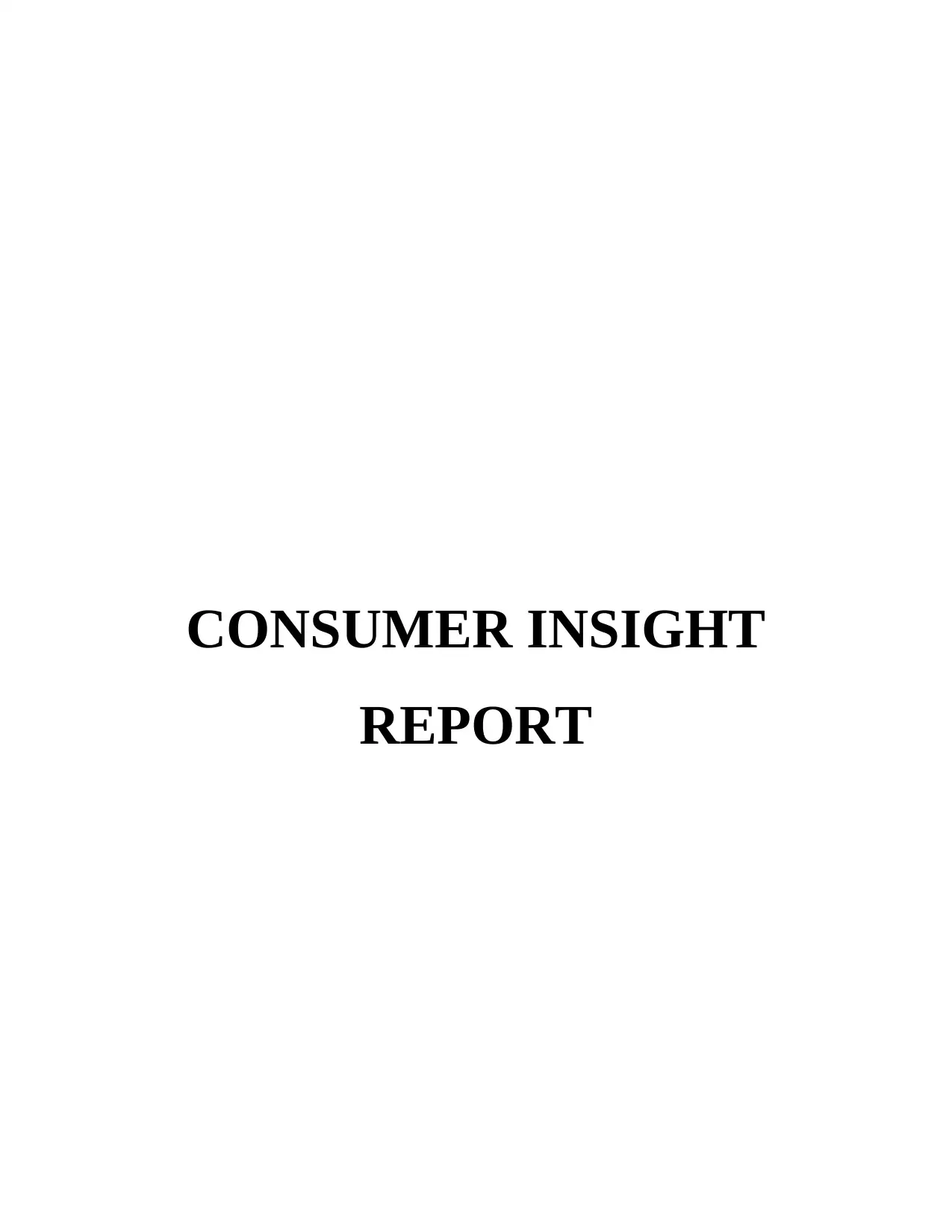
CONSUMER INSIGHT
REPORT
REPORT
Paraphrase This Document
Need a fresh take? Get an instant paraphrase of this document with our AI Paraphraser
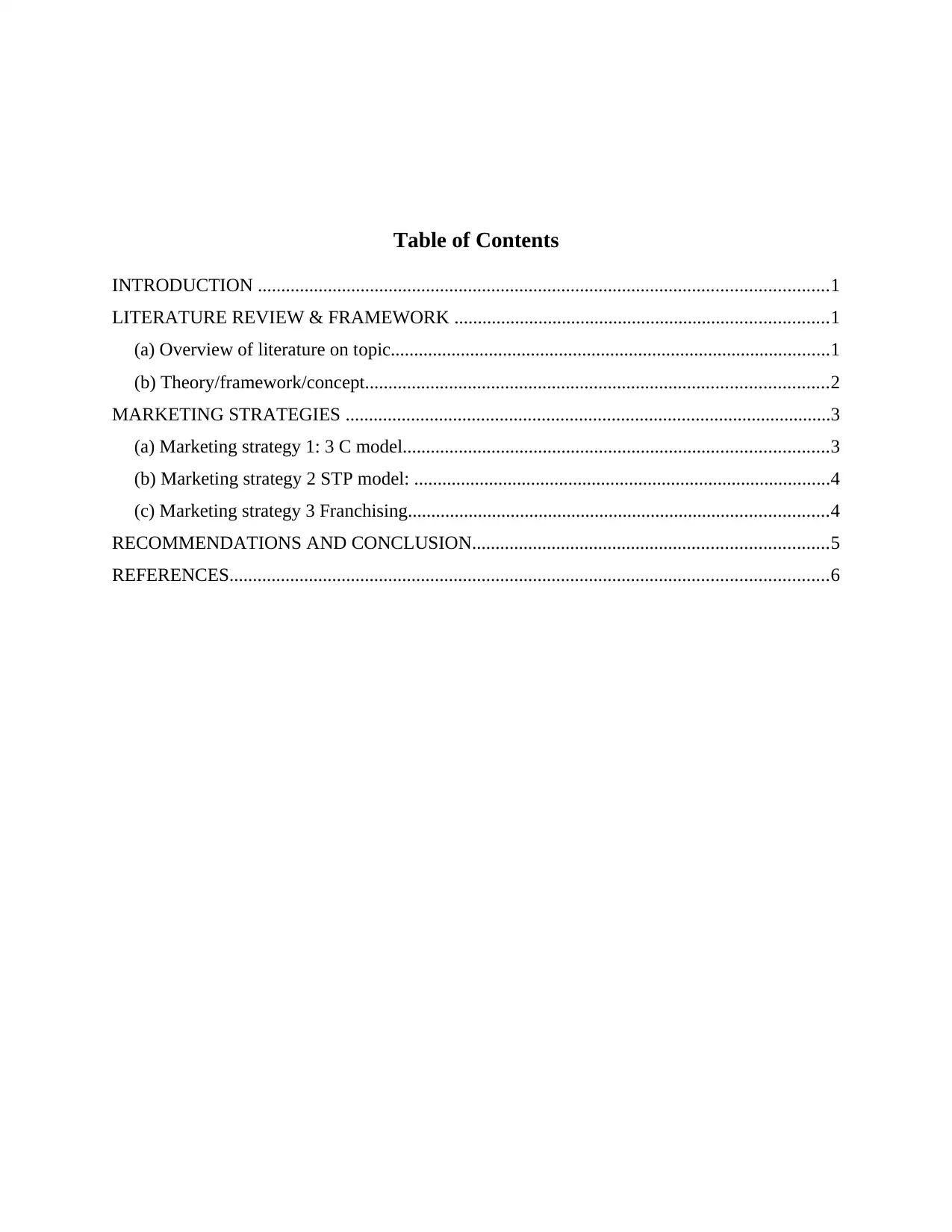
Table of Contents
INTRODUCTION ..........................................................................................................................1
LITERATURE REVIEW & FRAMEWORK ................................................................................1
(a) Overview of literature on topic..............................................................................................1
(b) Theory/framework/concept...................................................................................................2
MARKETING STRATEGIES ........................................................................................................3
(a) Marketing strategy 1: 3 C model...........................................................................................3
(b) Marketing strategy 2 STP model: .........................................................................................4
(c) Marketing strategy 3 Franchising..........................................................................................4
RECOMMENDATIONS AND CONCLUSION............................................................................5
REFERENCES................................................................................................................................6
INTRODUCTION ..........................................................................................................................1
LITERATURE REVIEW & FRAMEWORK ................................................................................1
(a) Overview of literature on topic..............................................................................................1
(b) Theory/framework/concept...................................................................................................2
MARKETING STRATEGIES ........................................................................................................3
(a) Marketing strategy 1: 3 C model...........................................................................................3
(b) Marketing strategy 2 STP model: .........................................................................................4
(c) Marketing strategy 3 Franchising..........................................................................................4
RECOMMENDATIONS AND CONCLUSION............................................................................5
REFERENCES................................................................................................................................6

⊘ This is a preview!⊘
Do you want full access?
Subscribe today to unlock all pages.

Trusted by 1+ million students worldwide
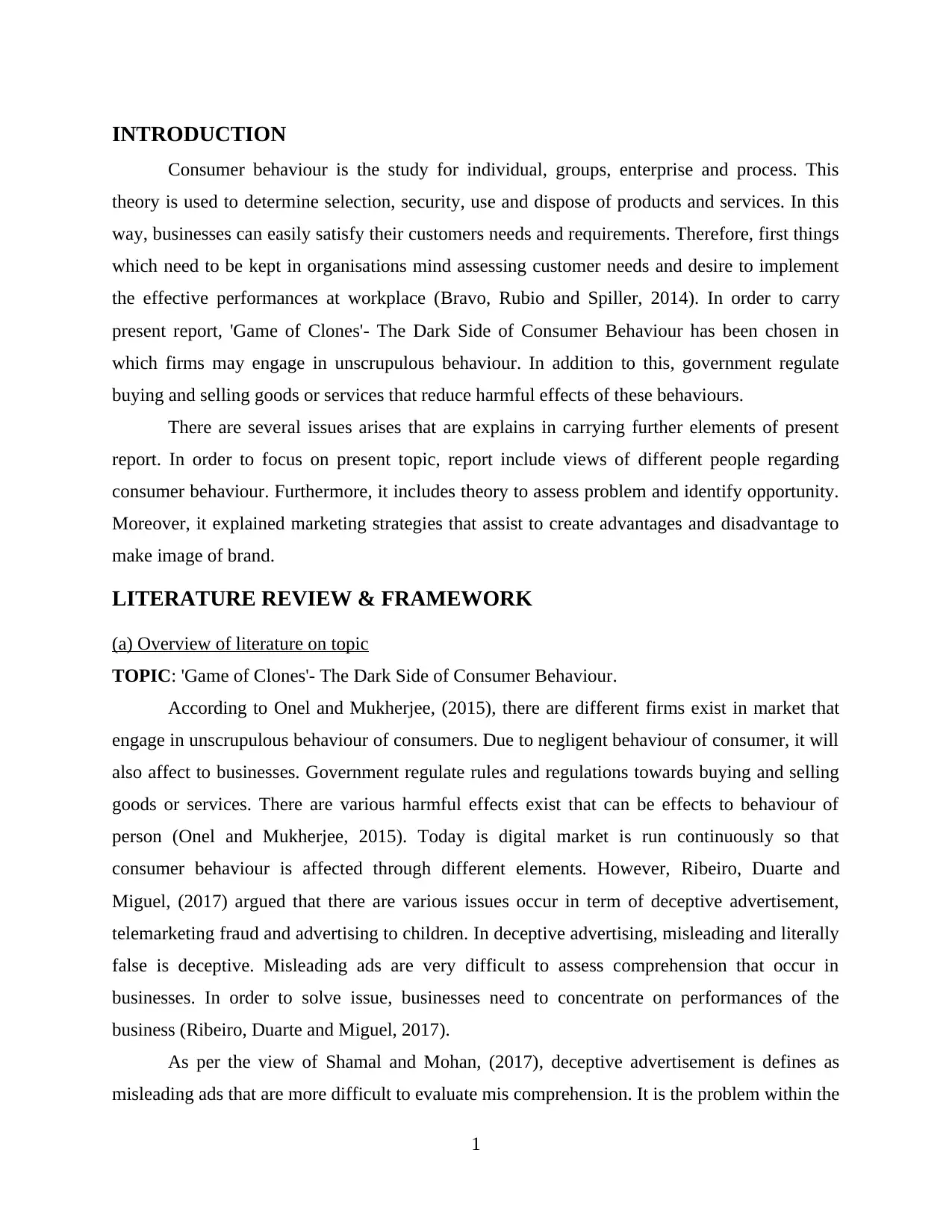
INTRODUCTION
Consumer behaviour is the study for individual, groups, enterprise and process. This
theory is used to determine selection, security, use and dispose of products and services. In this
way, businesses can easily satisfy their customers needs and requirements. Therefore, first things
which need to be kept in organisations mind assessing customer needs and desire to implement
the effective performances at workplace (Bravo, Rubio and Spiller, 2014). In order to carry
present report, 'Game of Clones'- The Dark Side of Consumer Behaviour has been chosen in
which firms may engage in unscrupulous behaviour. In addition to this, government regulate
buying and selling goods or services that reduce harmful effects of these behaviours.
There are several issues arises that are explains in carrying further elements of present
report. In order to focus on present topic, report include views of different people regarding
consumer behaviour. Furthermore, it includes theory to assess problem and identify opportunity.
Moreover, it explained marketing strategies that assist to create advantages and disadvantage to
make image of brand.
LITERATURE REVIEW & FRAMEWORK
(a) Overview of literature on topic
TOPIC: 'Game of Clones'- The Dark Side of Consumer Behaviour.
According to Onel and Mukherjee, (2015), there are different firms exist in market that
engage in unscrupulous behaviour of consumers. Due to negligent behaviour of consumer, it will
also affect to businesses. Government regulate rules and regulations towards buying and selling
goods or services. There are various harmful effects exist that can be effects to behaviour of
person (Onel and Mukherjee, 2015). Today is digital market is run continuously so that
consumer behaviour is affected through different elements. However, Ribeiro, Duarte and
Miguel, (2017) argued that there are various issues occur in term of deceptive advertisement,
telemarketing fraud and advertising to children. In deceptive advertising, misleading and literally
false is deceptive. Misleading ads are very difficult to assess comprehension that occur in
businesses. In order to solve issue, businesses need to concentrate on performances of the
business (Ribeiro, Duarte and Miguel, 2017).
As per the view of Shamal and Mohan, (2017), deceptive advertisement is defines as
misleading ads that are more difficult to evaluate mis comprehension. It is the problem within the
1
Consumer behaviour is the study for individual, groups, enterprise and process. This
theory is used to determine selection, security, use and dispose of products and services. In this
way, businesses can easily satisfy their customers needs and requirements. Therefore, first things
which need to be kept in organisations mind assessing customer needs and desire to implement
the effective performances at workplace (Bravo, Rubio and Spiller, 2014). In order to carry
present report, 'Game of Clones'- The Dark Side of Consumer Behaviour has been chosen in
which firms may engage in unscrupulous behaviour. In addition to this, government regulate
buying and selling goods or services that reduce harmful effects of these behaviours.
There are several issues arises that are explains in carrying further elements of present
report. In order to focus on present topic, report include views of different people regarding
consumer behaviour. Furthermore, it includes theory to assess problem and identify opportunity.
Moreover, it explained marketing strategies that assist to create advantages and disadvantage to
make image of brand.
LITERATURE REVIEW & FRAMEWORK
(a) Overview of literature on topic
TOPIC: 'Game of Clones'- The Dark Side of Consumer Behaviour.
According to Onel and Mukherjee, (2015), there are different firms exist in market that
engage in unscrupulous behaviour of consumers. Due to negligent behaviour of consumer, it will
also affect to businesses. Government regulate rules and regulations towards buying and selling
goods or services. There are various harmful effects exist that can be effects to behaviour of
person (Onel and Mukherjee, 2015). Today is digital market is run continuously so that
consumer behaviour is affected through different elements. However, Ribeiro, Duarte and
Miguel, (2017) argued that there are various issues occur in term of deceptive advertisement,
telemarketing fraud and advertising to children. In deceptive advertising, misleading and literally
false is deceptive. Misleading ads are very difficult to assess comprehension that occur in
businesses. In order to solve issue, businesses need to concentrate on performances of the
business (Ribeiro, Duarte and Miguel, 2017).
As per the view of Shamal and Mohan, (2017), deceptive advertisement is defines as
misleading ads that are more difficult to evaluate mis comprehension. It is the problem within the
1
Paraphrase This Document
Need a fresh take? Get an instant paraphrase of this document with our AI Paraphraser
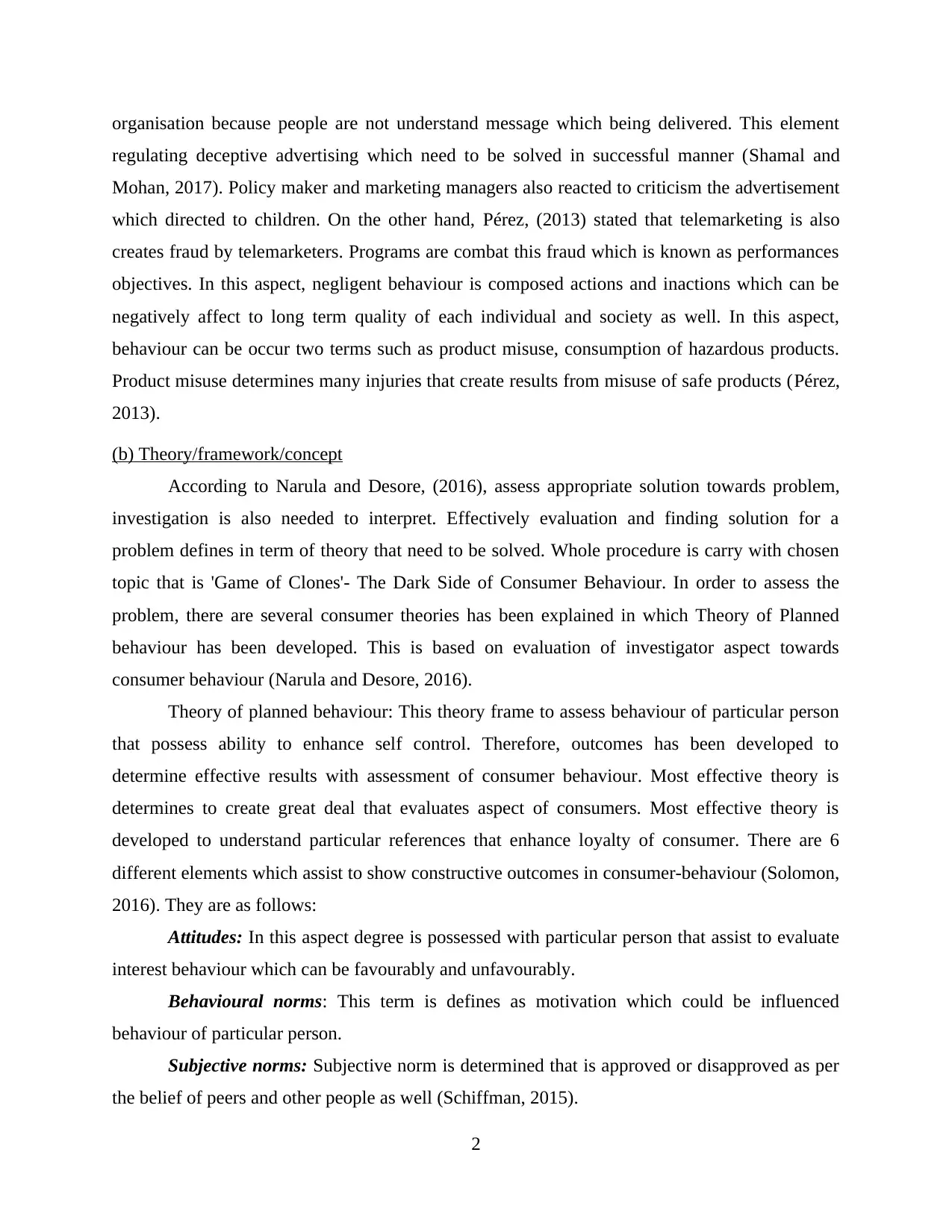
organisation because people are not understand message which being delivered. This element
regulating deceptive advertising which need to be solved in successful manner (Shamal and
Mohan, 2017). Policy maker and marketing managers also reacted to criticism the advertisement
which directed to children. On the other hand, Pérez, (2013) stated that telemarketing is also
creates fraud by telemarketers. Programs are combat this fraud which is known as performances
objectives. In this aspect, negligent behaviour is composed actions and inactions which can be
negatively affect to long term quality of each individual and society as well. In this aspect,
behaviour can be occur two terms such as product misuse, consumption of hazardous products.
Product misuse determines many injuries that create results from misuse of safe products (Pérez,
2013).
(b) Theory/framework/concept
According to Narula and Desore, (2016), assess appropriate solution towards problem,
investigation is also needed to interpret. Effectively evaluation and finding solution for a
problem defines in term of theory that need to be solved. Whole procedure is carry with chosen
topic that is 'Game of Clones'- The Dark Side of Consumer Behaviour. In order to assess the
problem, there are several consumer theories has been explained in which Theory of Planned
behaviour has been developed. This is based on evaluation of investigator aspect towards
consumer behaviour (Narula and Desore, 2016).
Theory of planned behaviour: This theory frame to assess behaviour of particular person
that possess ability to enhance self control. Therefore, outcomes has been developed to
determine effective results with assessment of consumer behaviour. Most effective theory is
determines to create great deal that evaluates aspect of consumers. Most effective theory is
developed to understand particular references that enhance loyalty of consumer. There are 6
different elements which assist to show constructive outcomes in consumer-behaviour (Solomon,
2016). They are as follows:
Attitudes: In this aspect degree is possessed with particular person that assist to evaluate
interest behaviour which can be favourably and unfavourably.
Behavioural norms: This term is defines as motivation which could be influenced
behaviour of particular person.
Subjective norms: Subjective norm is determined that is approved or disapproved as per
the belief of peers and other people as well (Schiffman, 2015).
2
regulating deceptive advertising which need to be solved in successful manner (Shamal and
Mohan, 2017). Policy maker and marketing managers also reacted to criticism the advertisement
which directed to children. On the other hand, Pérez, (2013) stated that telemarketing is also
creates fraud by telemarketers. Programs are combat this fraud which is known as performances
objectives. In this aspect, negligent behaviour is composed actions and inactions which can be
negatively affect to long term quality of each individual and society as well. In this aspect,
behaviour can be occur two terms such as product misuse, consumption of hazardous products.
Product misuse determines many injuries that create results from misuse of safe products (Pérez,
2013).
(b) Theory/framework/concept
According to Narula and Desore, (2016), assess appropriate solution towards problem,
investigation is also needed to interpret. Effectively evaluation and finding solution for a
problem defines in term of theory that need to be solved. Whole procedure is carry with chosen
topic that is 'Game of Clones'- The Dark Side of Consumer Behaviour. In order to assess the
problem, there are several consumer theories has been explained in which Theory of Planned
behaviour has been developed. This is based on evaluation of investigator aspect towards
consumer behaviour (Narula and Desore, 2016).
Theory of planned behaviour: This theory frame to assess behaviour of particular person
that possess ability to enhance self control. Therefore, outcomes has been developed to
determine effective results with assessment of consumer behaviour. Most effective theory is
determines to create great deal that evaluates aspect of consumers. Most effective theory is
developed to understand particular references that enhance loyalty of consumer. There are 6
different elements which assist to show constructive outcomes in consumer-behaviour (Solomon,
2016). They are as follows:
Attitudes: In this aspect degree is possessed with particular person that assist to evaluate
interest behaviour which can be favourably and unfavourably.
Behavioural norms: This term is defines as motivation which could be influenced
behaviour of particular person.
Subjective norms: Subjective norm is determined that is approved or disapproved as per
the belief of peers and other people as well (Schiffman, 2015).
2
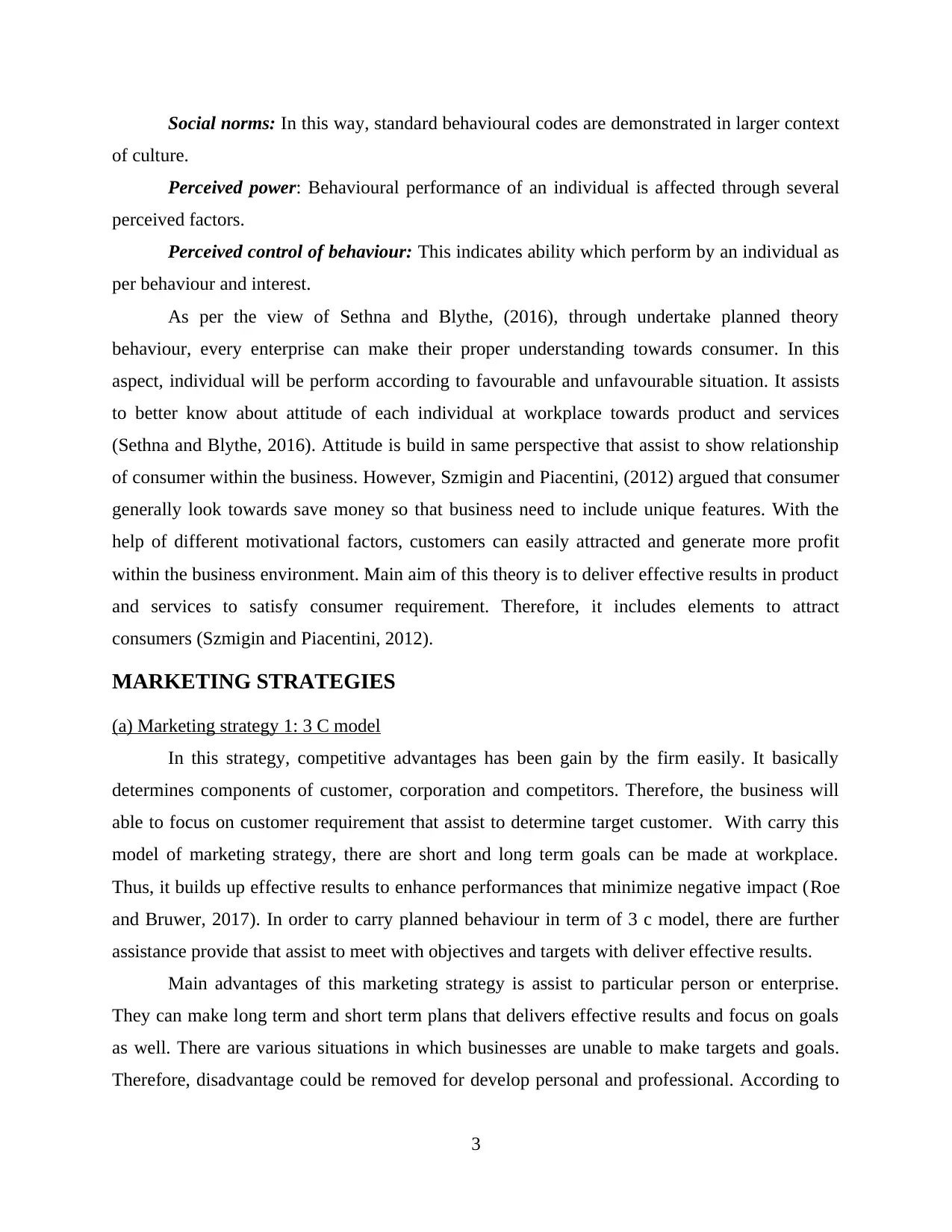
Social norms: In this way, standard behavioural codes are demonstrated in larger context
of culture.
Perceived power: Behavioural performance of an individual is affected through several
perceived factors.
Perceived control of behaviour: This indicates ability which perform by an individual as
per behaviour and interest.
As per the view of Sethna and Blythe, (2016), through undertake planned theory
behaviour, every enterprise can make their proper understanding towards consumer. In this
aspect, individual will be perform according to favourable and unfavourable situation. It assists
to better know about attitude of each individual at workplace towards product and services
(Sethna and Blythe, 2016). Attitude is build in same perspective that assist to show relationship
of consumer within the business. However, Szmigin and Piacentini, (2012) argued that consumer
generally look towards save money so that business need to include unique features. With the
help of different motivational factors, customers can easily attracted and generate more profit
within the business environment. Main aim of this theory is to deliver effective results in product
and services to satisfy consumer requirement. Therefore, it includes elements to attract
consumers (Szmigin and Piacentini, 2012).
MARKETING STRATEGIES
(a) Marketing strategy 1: 3 C model
In this strategy, competitive advantages has been gain by the firm easily. It basically
determines components of customer, corporation and competitors. Therefore, the business will
able to focus on customer requirement that assist to determine target customer. With carry this
model of marketing strategy, there are short and long term goals can be made at workplace.
Thus, it builds up effective results to enhance performances that minimize negative impact (Roe
and Bruwer, 2017). In order to carry planned behaviour in term of 3 c model, there are further
assistance provide that assist to meet with objectives and targets with deliver effective results.
Main advantages of this marketing strategy is assist to particular person or enterprise.
They can make long term and short term plans that delivers effective results and focus on goals
as well. There are various situations in which businesses are unable to make targets and goals.
Therefore, disadvantage could be removed for develop personal and professional. According to
3
of culture.
Perceived power: Behavioural performance of an individual is affected through several
perceived factors.
Perceived control of behaviour: This indicates ability which perform by an individual as
per behaviour and interest.
As per the view of Sethna and Blythe, (2016), through undertake planned theory
behaviour, every enterprise can make their proper understanding towards consumer. In this
aspect, individual will be perform according to favourable and unfavourable situation. It assists
to better know about attitude of each individual at workplace towards product and services
(Sethna and Blythe, 2016). Attitude is build in same perspective that assist to show relationship
of consumer within the business. However, Szmigin and Piacentini, (2012) argued that consumer
generally look towards save money so that business need to include unique features. With the
help of different motivational factors, customers can easily attracted and generate more profit
within the business environment. Main aim of this theory is to deliver effective results in product
and services to satisfy consumer requirement. Therefore, it includes elements to attract
consumers (Szmigin and Piacentini, 2012).
MARKETING STRATEGIES
(a) Marketing strategy 1: 3 C model
In this strategy, competitive advantages has been gain by the firm easily. It basically
determines components of customer, corporation and competitors. Therefore, the business will
able to focus on customer requirement that assist to determine target customer. With carry this
model of marketing strategy, there are short and long term goals can be made at workplace.
Thus, it builds up effective results to enhance performances that minimize negative impact (Roe
and Bruwer, 2017). In order to carry planned behaviour in term of 3 c model, there are further
assistance provide that assist to meet with objectives and targets with deliver effective results.
Main advantages of this marketing strategy is assist to particular person or enterprise.
They can make long term and short term plans that delivers effective results and focus on goals
as well. There are various situations in which businesses are unable to make targets and goals.
Therefore, disadvantage could be removed for develop personal and professional. According to
3
⊘ This is a preview!⊘
Do you want full access?
Subscribe today to unlock all pages.

Trusted by 1+ million students worldwide
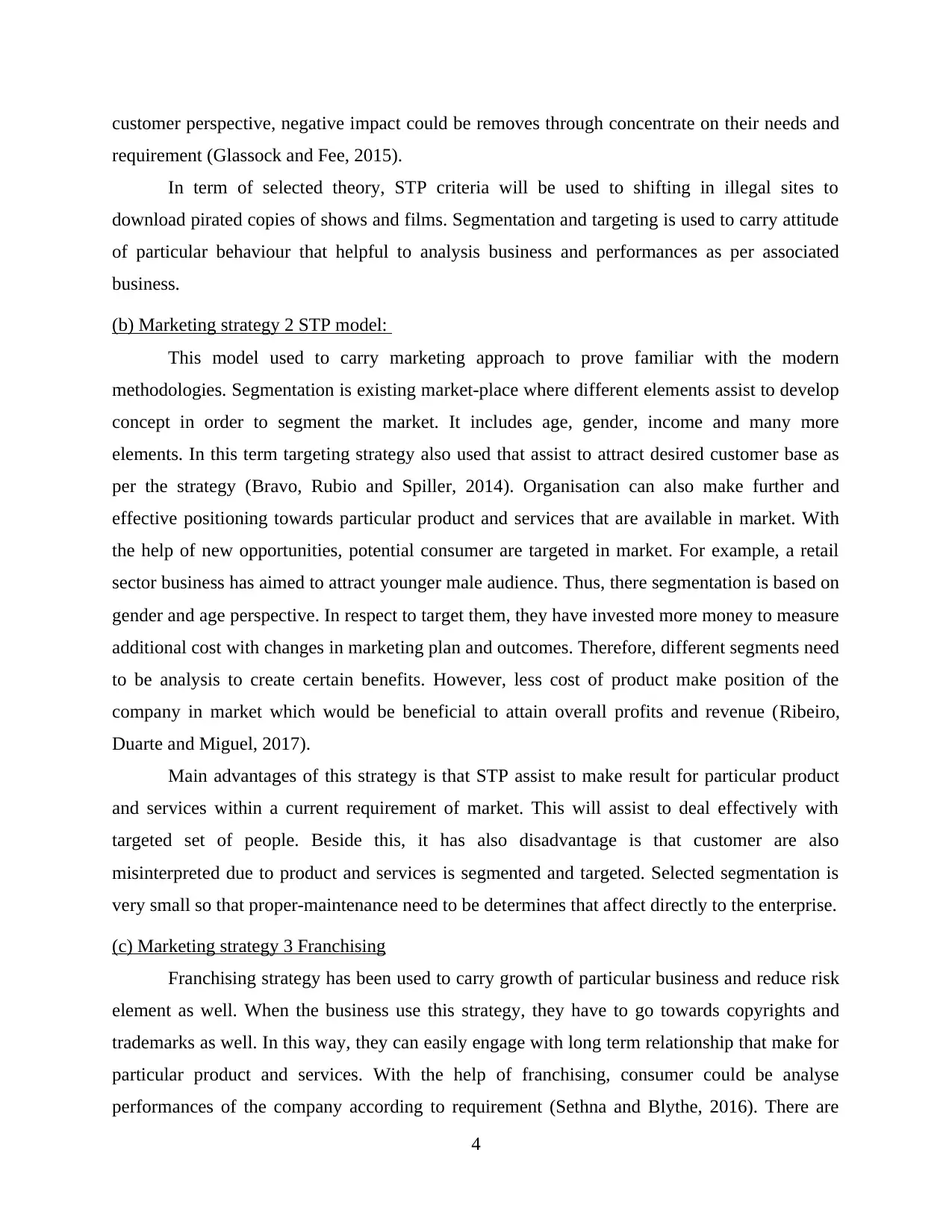
customer perspective, negative impact could be removes through concentrate on their needs and
requirement (Glassock and Fee, 2015).
In term of selected theory, STP criteria will be used to shifting in illegal sites to
download pirated copies of shows and films. Segmentation and targeting is used to carry attitude
of particular behaviour that helpful to analysis business and performances as per associated
business.
(b) Marketing strategy 2 STP model:
This model used to carry marketing approach to prove familiar with the modern
methodologies. Segmentation is existing market-place where different elements assist to develop
concept in order to segment the market. It includes age, gender, income and many more
elements. In this term targeting strategy also used that assist to attract desired customer base as
per the strategy (Bravo, Rubio and Spiller, 2014). Organisation can also make further and
effective positioning towards particular product and services that are available in market. With
the help of new opportunities, potential consumer are targeted in market. For example, a retail
sector business has aimed to attract younger male audience. Thus, there segmentation is based on
gender and age perspective. In respect to target them, they have invested more money to measure
additional cost with changes in marketing plan and outcomes. Therefore, different segments need
to be analysis to create certain benefits. However, less cost of product make position of the
company in market which would be beneficial to attain overall profits and revenue (Ribeiro,
Duarte and Miguel, 2017).
Main advantages of this strategy is that STP assist to make result for particular product
and services within a current requirement of market. This will assist to deal effectively with
targeted set of people. Beside this, it has also disadvantage is that customer are also
misinterpreted due to product and services is segmented and targeted. Selected segmentation is
very small so that proper-maintenance need to be determines that affect directly to the enterprise.
(c) Marketing strategy 3 Franchising
Franchising strategy has been used to carry growth of particular business and reduce risk
element as well. When the business use this strategy, they have to go towards copyrights and
trademarks as well. In this way, they can easily engage with long term relationship that make for
particular product and services. With the help of franchising, consumer could be analyse
performances of the company according to requirement (Sethna and Blythe, 2016). There are
4
requirement (Glassock and Fee, 2015).
In term of selected theory, STP criteria will be used to shifting in illegal sites to
download pirated copies of shows and films. Segmentation and targeting is used to carry attitude
of particular behaviour that helpful to analysis business and performances as per associated
business.
(b) Marketing strategy 2 STP model:
This model used to carry marketing approach to prove familiar with the modern
methodologies. Segmentation is existing market-place where different elements assist to develop
concept in order to segment the market. It includes age, gender, income and many more
elements. In this term targeting strategy also used that assist to attract desired customer base as
per the strategy (Bravo, Rubio and Spiller, 2014). Organisation can also make further and
effective positioning towards particular product and services that are available in market. With
the help of new opportunities, potential consumer are targeted in market. For example, a retail
sector business has aimed to attract younger male audience. Thus, there segmentation is based on
gender and age perspective. In respect to target them, they have invested more money to measure
additional cost with changes in marketing plan and outcomes. Therefore, different segments need
to be analysis to create certain benefits. However, less cost of product make position of the
company in market which would be beneficial to attain overall profits and revenue (Ribeiro,
Duarte and Miguel, 2017).
Main advantages of this strategy is that STP assist to make result for particular product
and services within a current requirement of market. This will assist to deal effectively with
targeted set of people. Beside this, it has also disadvantage is that customer are also
misinterpreted due to product and services is segmented and targeted. Selected segmentation is
very small so that proper-maintenance need to be determines that affect directly to the enterprise.
(c) Marketing strategy 3 Franchising
Franchising strategy has been used to carry growth of particular business and reduce risk
element as well. When the business use this strategy, they have to go towards copyrights and
trademarks as well. In this way, they can easily engage with long term relationship that make for
particular product and services. With the help of franchising, consumer could be analyse
performances of the company according to requirement (Sethna and Blythe, 2016). There are
4
Paraphrase This Document
Need a fresh take? Get an instant paraphrase of this document with our AI Paraphraser
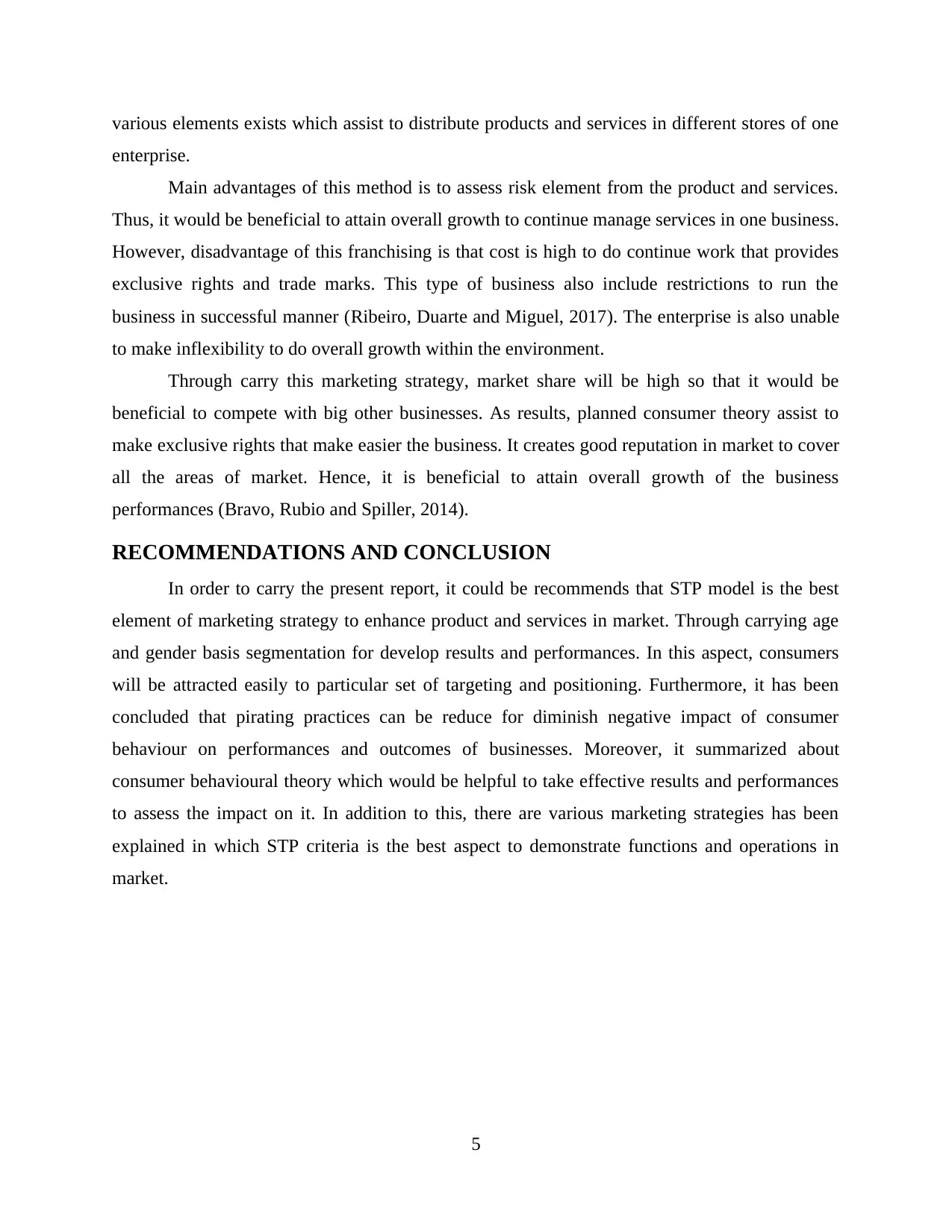
various elements exists which assist to distribute products and services in different stores of one
enterprise.
Main advantages of this method is to assess risk element from the product and services.
Thus, it would be beneficial to attain overall growth to continue manage services in one business.
However, disadvantage of this franchising is that cost is high to do continue work that provides
exclusive rights and trade marks. This type of business also include restrictions to run the
business in successful manner (Ribeiro, Duarte and Miguel, 2017). The enterprise is also unable
to make inflexibility to do overall growth within the environment.
Through carry this marketing strategy, market share will be high so that it would be
beneficial to compete with big other businesses. As results, planned consumer theory assist to
make exclusive rights that make easier the business. It creates good reputation in market to cover
all the areas of market. Hence, it is beneficial to attain overall growth of the business
performances (Bravo, Rubio and Spiller, 2014).
RECOMMENDATIONS AND CONCLUSION
In order to carry the present report, it could be recommends that STP model is the best
element of marketing strategy to enhance product and services in market. Through carrying age
and gender basis segmentation for develop results and performances. In this aspect, consumers
will be attracted easily to particular set of targeting and positioning. Furthermore, it has been
concluded that pirating practices can be reduce for diminish negative impact of consumer
behaviour on performances and outcomes of businesses. Moreover, it summarized about
consumer behavioural theory which would be helpful to take effective results and performances
to assess the impact on it. In addition to this, there are various marketing strategies has been
explained in which STP criteria is the best aspect to demonstrate functions and operations in
market.
5
enterprise.
Main advantages of this method is to assess risk element from the product and services.
Thus, it would be beneficial to attain overall growth to continue manage services in one business.
However, disadvantage of this franchising is that cost is high to do continue work that provides
exclusive rights and trade marks. This type of business also include restrictions to run the
business in successful manner (Ribeiro, Duarte and Miguel, 2017). The enterprise is also unable
to make inflexibility to do overall growth within the environment.
Through carry this marketing strategy, market share will be high so that it would be
beneficial to compete with big other businesses. As results, planned consumer theory assist to
make exclusive rights that make easier the business. It creates good reputation in market to cover
all the areas of market. Hence, it is beneficial to attain overall growth of the business
performances (Bravo, Rubio and Spiller, 2014).
RECOMMENDATIONS AND CONCLUSION
In order to carry the present report, it could be recommends that STP model is the best
element of marketing strategy to enhance product and services in market. Through carrying age
and gender basis segmentation for develop results and performances. In this aspect, consumers
will be attracted easily to particular set of targeting and positioning. Furthermore, it has been
concluded that pirating practices can be reduce for diminish negative impact of consumer
behaviour on performances and outcomes of businesses. Moreover, it summarized about
consumer behavioural theory which would be helpful to take effective results and performances
to assess the impact on it. In addition to this, there are various marketing strategies has been
explained in which STP criteria is the best aspect to demonstrate functions and operations in
market.
5
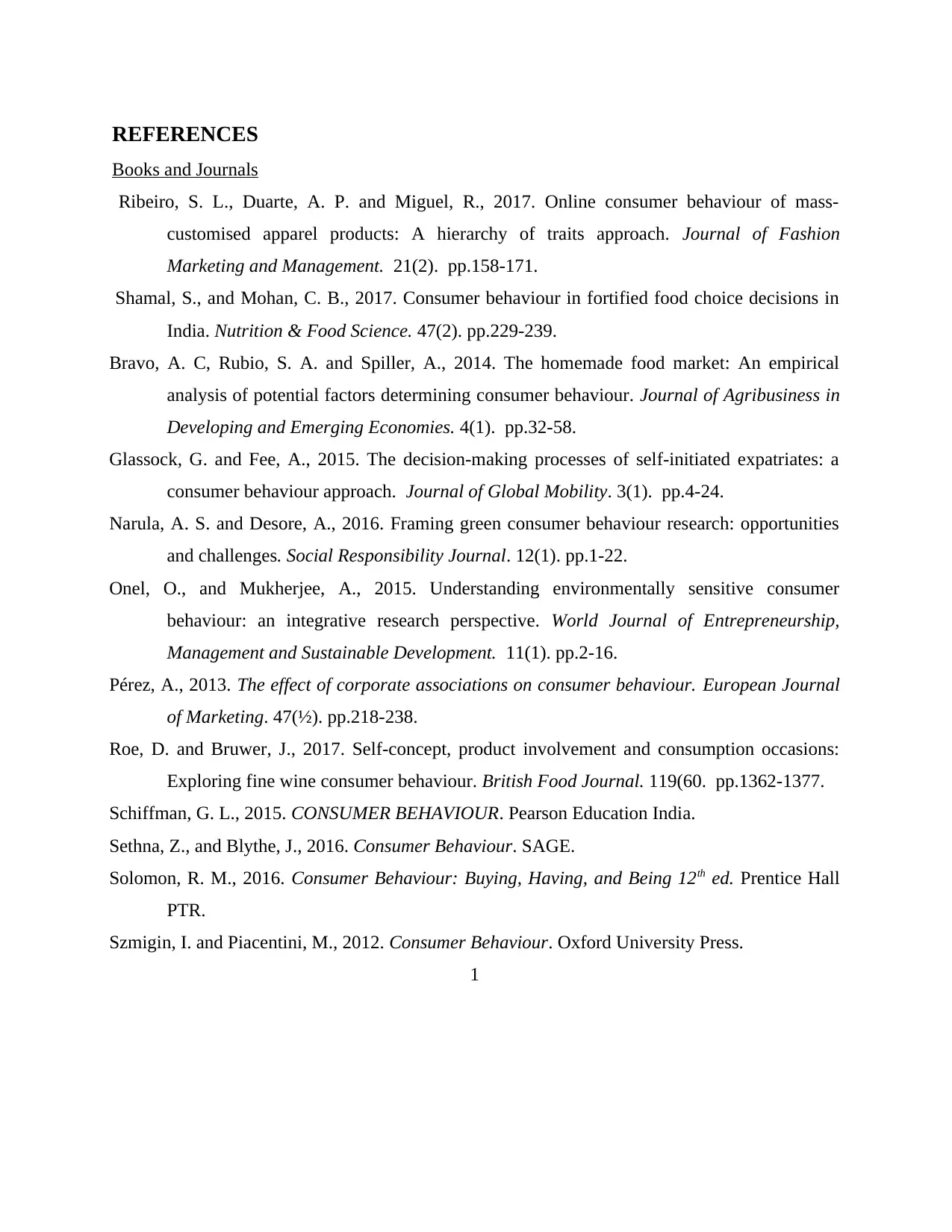
REFERENCES
Books and Journals
Ribeiro, S. L., Duarte, A. P. and Miguel, R., 2017. Online consumer behaviour of mass-
customised apparel products: A hierarchy of traits approach. Journal of Fashion
Marketing and Management. 21(2). pp.158-171.
Shamal, S., and Mohan, C. B., 2017. Consumer behaviour in fortified food choice decisions in
India. Nutrition & Food Science. 47(2). pp.229-239.
Bravo, A. C, Rubio, S. A. and Spiller, A., 2014. The homemade food market: An empirical
analysis of potential factors determining consumer behaviour. Journal of Agribusiness in
Developing and Emerging Economies. 4(1). pp.32-58.
Glassock, G. and Fee, A., 2015. The decision-making processes of self-initiated expatriates: a
consumer behaviour approach. Journal of Global Mobility. 3(1). pp.4-24.
Narula, A. S. and Desore, A., 2016. Framing green consumer behaviour research: opportunities
and challenges. Social Responsibility Journal. 12(1). pp.1-22.
Onel, O., and Mukherjee, A., 2015. Understanding environmentally sensitive consumer
behaviour: an integrative research perspective. World Journal of Entrepreneurship,
Management and Sustainable Development. 11(1). pp.2-16.
Pérez, A., 2013. The effect of corporate associations on consumer behaviour. European Journal
of Marketing. 47(½). pp.218-238.
Roe, D. and Bruwer, J., 2017. Self-concept, product involvement and consumption occasions:
Exploring fine wine consumer behaviour. British Food Journal. 119(60. pp.1362-1377.
Schiffman, G. L., 2015. CONSUMER BEHAVIOUR. Pearson Education India.
Sethna, Z., and Blythe, J., 2016. Consumer Behaviour. SAGE.
Solomon, R. M., 2016. Consumer Behaviour: Buying, Having, and Being 12th ed. Prentice Hall
PTR.
Szmigin, I. and Piacentini, M., 2012. Consumer Behaviour. Oxford University Press.
1
Books and Journals
Ribeiro, S. L., Duarte, A. P. and Miguel, R., 2017. Online consumer behaviour of mass-
customised apparel products: A hierarchy of traits approach. Journal of Fashion
Marketing and Management. 21(2). pp.158-171.
Shamal, S., and Mohan, C. B., 2017. Consumer behaviour in fortified food choice decisions in
India. Nutrition & Food Science. 47(2). pp.229-239.
Bravo, A. C, Rubio, S. A. and Spiller, A., 2014. The homemade food market: An empirical
analysis of potential factors determining consumer behaviour. Journal of Agribusiness in
Developing and Emerging Economies. 4(1). pp.32-58.
Glassock, G. and Fee, A., 2015. The decision-making processes of self-initiated expatriates: a
consumer behaviour approach. Journal of Global Mobility. 3(1). pp.4-24.
Narula, A. S. and Desore, A., 2016. Framing green consumer behaviour research: opportunities
and challenges. Social Responsibility Journal. 12(1). pp.1-22.
Onel, O., and Mukherjee, A., 2015. Understanding environmentally sensitive consumer
behaviour: an integrative research perspective. World Journal of Entrepreneurship,
Management and Sustainable Development. 11(1). pp.2-16.
Pérez, A., 2013. The effect of corporate associations on consumer behaviour. European Journal
of Marketing. 47(½). pp.218-238.
Roe, D. and Bruwer, J., 2017. Self-concept, product involvement and consumption occasions:
Exploring fine wine consumer behaviour. British Food Journal. 119(60. pp.1362-1377.
Schiffman, G. L., 2015. CONSUMER BEHAVIOUR. Pearson Education India.
Sethna, Z., and Blythe, J., 2016. Consumer Behaviour. SAGE.
Solomon, R. M., 2016. Consumer Behaviour: Buying, Having, and Being 12th ed. Prentice Hall
PTR.
Szmigin, I. and Piacentini, M., 2012. Consumer Behaviour. Oxford University Press.
1
⊘ This is a preview!⊘
Do you want full access?
Subscribe today to unlock all pages.

Trusted by 1+ million students worldwide
1 out of 9
Your All-in-One AI-Powered Toolkit for Academic Success.
+13062052269
info@desklib.com
Available 24*7 on WhatsApp / Email
![[object Object]](/_next/static/media/star-bottom.7253800d.svg)
Unlock your academic potential
Copyright © 2020–2025 A2Z Services. All Rights Reserved. Developed and managed by ZUCOL.

